Journal of the NACAA
ISSN 2158-9429
Volume 10, Issue 2 - December, 2017
Identifying Equine-Related Cooperative Extension Program Priorities in Arizona via a Statewide Survey
- Greene, E.A. , Extension Equine Specialist, University of Arizona Cooperative Extension
Wright, A.D., Livestock Area Agent, Southeastern Arizona, University of Arizona Cooperative Extension
ABSTRACT
An online livestock/equine survey was created and disseminated to Arizona equine industry stakeholders through multiple avenues including social media, email listservs, personal connections, and was made available in a hard copy format. The last known statewide survey was completed in 2002 and equine questions had a strong emphasis on reproduction. The goal of the current survey was to identify clientele needs and perceptions following a recent two-year void in equine extension programming at the University of Arizona due to faculty retirements. The data from this survey is being used to design programs and publications to address topics with reported moderate to critical need, as well as incorporating important subjects which support good business practices, land and animal stewardship, and horse health, safety, and welfare.
Introduction
Arizona’s year round riding weather and abundant access to trails, washes, and public lands ensure that the Arizona equine industry is thriving and vibrant. The 92,394 horses throughout the state (USDA, 2014) have a robust financial impact on Arizona’s agricultural and state economy through direct (e.g. horse sales, instruction, training/breeding businesses) and indirect (use/support of hay growers, farm stores, truck/trailer businesses, veterinarians, etc.) contribution. The activities and disciplines supporting economic impact run the gamut from recreational trail riding to professional rodeos, and internationally recognized and attended equine events. Additionally, the equine industry helps draw in tourists as guest ranches across the state offer resort style accommodations, guided horseback rides, and a myriad of other activities for locals and tourists alike.
Although a majority of equine owners may be classified as recreation participants, traditional working equines are still a valued part of Arizona’s history and working agricultural landscapes. Cow-calf operations (ranches) are scattered across Arizona. These ranches contribute an estimated $814 million in sales to the Arizona economy (Kerna et al., 2014), and working ranch horses are vital to their operations. Horses can get into terrain that is impassable by truck or even ATV, are nimble enough to move cattle through brush, and can be used to work cattle or calves far from ranch headquarters. The average ranch in Arizona has between five and ten working horses (Teegerstrom and Tronstad, 2017) but this number may not account for horses owned by hired help and used on the operation.
University of Arizona Cooperative Extension (UA-CE) delivers equine related educational programming to recreational equine owners, equine business owners, and 4-H/youth participants. The last survey of Arizona livestock producers and equine owners was done in 2002. With several new faculty, including an equine extension specialist and a livestock area assistant agent, it was important to administer an updated survey to assess livestock and equine stakeholder needs, and to aid in defining extension programmatic directions. With many equines in Arizona used for business purposes (working ranch horses, race horses, trainers, etc.), the survey was designed to assess the differing needs of business owners and recreational riders. This data will create a baseline for designing and measuring impacts of future programming. Understanding the current needs of program stakeholders is critical to developing programming that will engage Arizona equine owners and business professionals.
Materials and Methods
The online survey was created and administered using Qualtrics® software (Qualtrics, 2016). Survey questions were modified from an Arizona Cooperative Extension livestock stakeholder survey last completed in 2002. The most recent survey was available from December 2015 through May 2016 with multiple rounds of promotion during this time period to reach as many people as possible. It was distributed to livestock and equine producers through a variety of online avenues including social media, University of Arizona websites, and emails/listservs. In addition, UA-CE Agriculture and 4-H agents were asked to distribute the survey to their local contacts throughout the state. The survey information was also printed in the December 2015 issue of the Arizona Cattlelog (Wright, 2015), a monthly publication of the Arizona Cattle Growers’ Association that is sent out to all of their members in the state.
The survey consisted of three sections of questions: General questions, species specific questions, and demographic questions. The general section contained questions related to location, land types (private, state, federal, and/or tribal), current sources of information, and preferred methods of delivery for educational programs. Survey takers were then asked to select the livestock species they own/raise. Their selected answer(s) determined which group(s) of species questions they were shown in the species specific questions. The four species sections were Equine/Horse, Beef Cattle, Dairy Cattle, or General Livestock (alpaca/llama, dairy goat, meat goat, rabbit, poultry, sheep, swine, or other). Participants who selected multiple species were shown questions for all species sections they selected. All respondents were presented the third section of demographic questions related to age, gender, and ethnicity. This survey was deemed program evaluation, and therefore exempted from Human Subject requirements by the University of Arizona Institutional Review Board.
Equine survey results were separated from the larger pool containing dairy cattle, beef cattle, and other livestock producers/owners for analysis. Equine survey takers answered questions about the number of equines they own, lease, or borrow, the events or disciplines they participate in, and if their horses are used for business, recreation, or both. They were also asked if they had ever attended an equine event hosted by UA-CE. Following these questions, 22 topics related to equine business management, equine business planning, feed forages and nutrition, horse health, and horse behavior and training were presented to be ranked as “no need,” “slight need,” “moderate need,” or “critical need.”
Results and Discussion
The following results represent 277 respondents who answered the equine section of the survey. While there was statewide representation from all 15 Arizona Counties, not surprisingly, there were more respondents from Maricopa and Pima Counties (Phoenix metro areas and Tucson). These two counties rank second and fifth, respectively in horse population in the state, and provide venues for multiple national and regional horse competitions (e.g. Scottsdale Arabian Show, Arizona Sun Circuit).
Survey Results: Of those who responded to the survey, most (95%) own their own horse(s) with 55% owning one to three, 22% owning four to six, 12% owning seven to nine, and 11% owning more than ten horses (Figure 1). Most horses (54%) were used for recreation only, 37% were used for both business and recreation, while only 9% were used exclusively for business (Figure 2). Many equine professionals are introduced to their future careers at an early age via equine activities such as lessons, recreational riding, showing, 4-H or FFA contests involving horse judging or riding. This lifelong tie to horses may account for the large number of respondents using horses for both business and recreation. Many horse operations differ significantly from traditional livestock businesses, in that other livestock businesses often do not deal with the public on a daily basis. Horse operations, however, usually depend on the horse owning/loving public for their business to succeed. Without a horse clientele to feed into their business plan, whether it involves riding lessons, boarding horses, training or breeding operations, their business will not succeed. Therefore, it is not surprising that there were a large percentage of respondents who are horse owners (consumers), but are not necessarily engaged in equine business. The majority (Figure 3) of survey takers were 30-69 years old (76%) and female (78%).
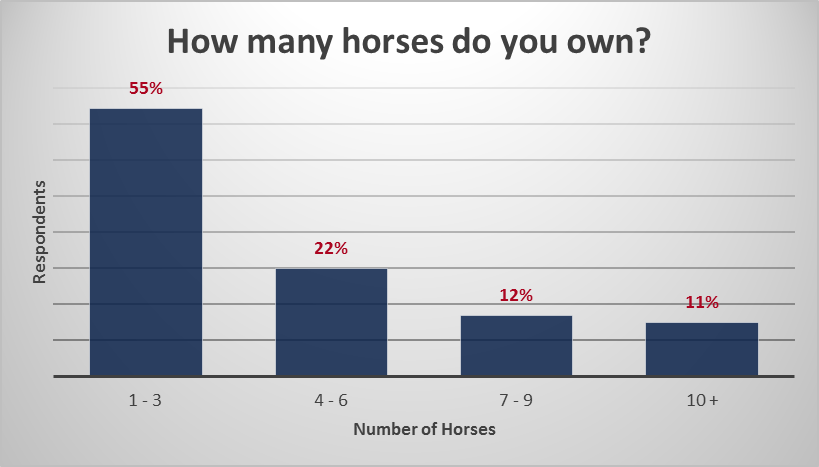
Figure 1. Over half (55%) of respondents owned up to 3 horses, while 23% owned seven or more horses
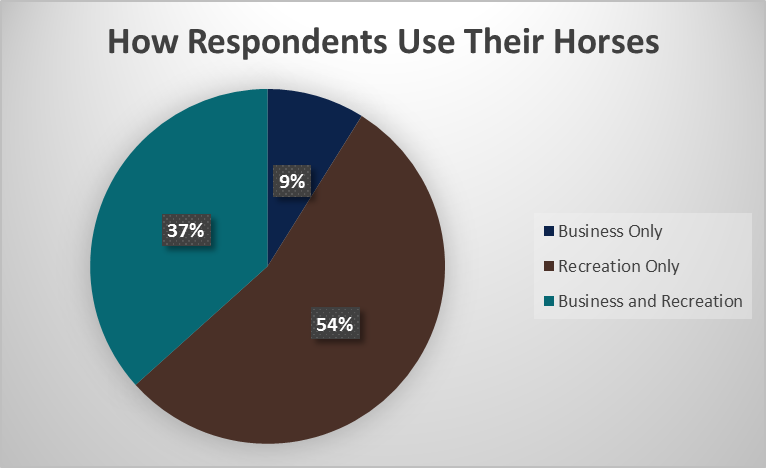
Figure 2. When asked whether horses were used for business, recreation, or both, 54% of respondents own horses for recreation, only 9% of horses were used strictly for business, and 37% were used for both business and recreation.
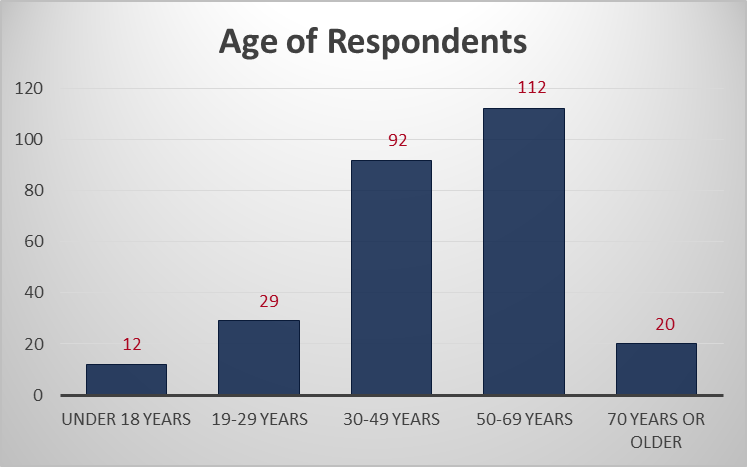
Figure 3. Of 265 equine species respondents who chose to answer the age demographic question, 78% were female and 77% were between 30-69 years of age.
The preferred sources of information (Figure 4) for survey respondents, when asked to indicate their top three, were veterinarians (24%), publications or magazines (22%), and other ranchers/producers (20%). Only 9% of respondents indicated that they used UA-CE for equine information. This highlights a misunderstanding or potential disconnect between UA-CE and 4-H (A UA-CE youth program) by respondents. While only 9% reported using extension, a total of 36% of respondents indicated that they attended 4-H events. While many may not currently find UA-CE valuable for seeking out information, it appears that many simply do not understand that 4-H is a UA-CE program. This issue can be addressed in UA-CE publicity and marketing efforts.
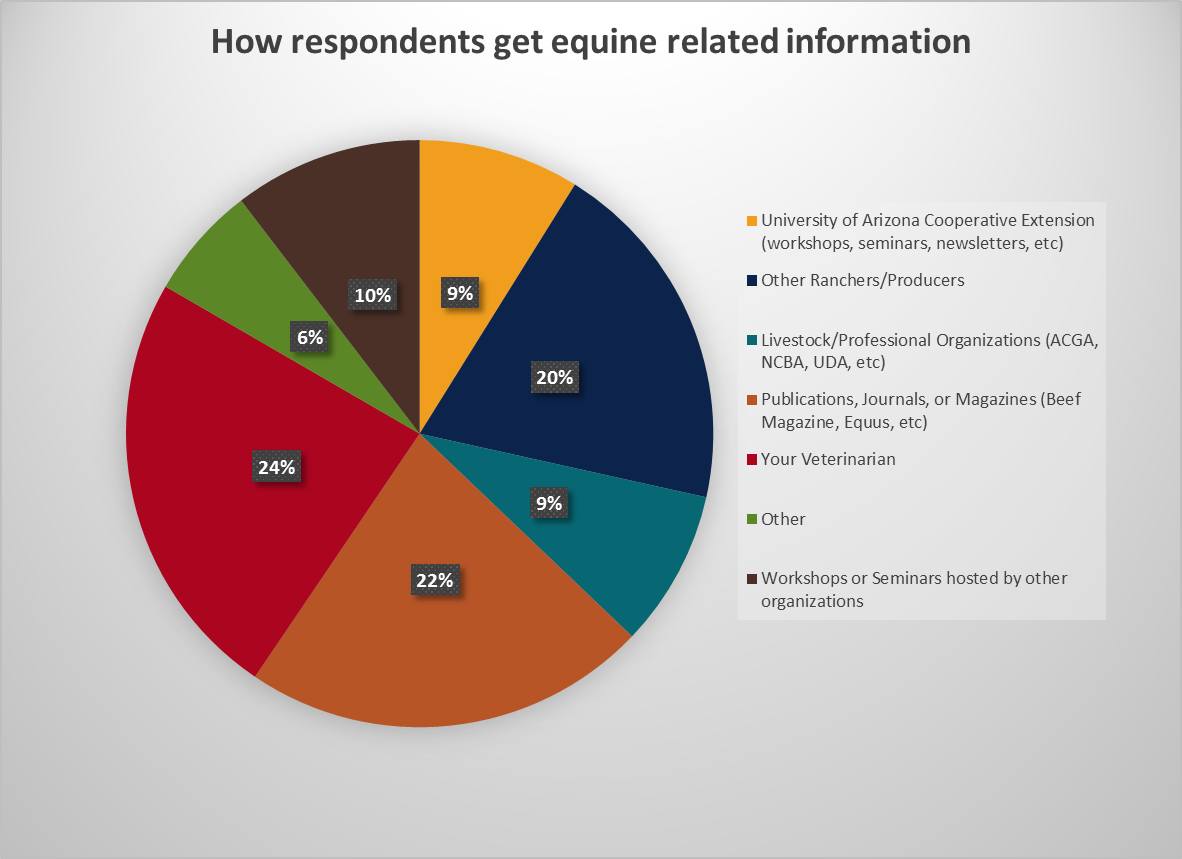
Figure 4. When asked to select their top three places to get equine information, only 9% indicated they utilize Arizona Cooperative Extension. Since 36% of respondents indicate involvement with 4-H (member or leader), it is clear there is a lot of work to broaden the reach of extension education among clientele
Respondents’ preferred methods of program delivery (select top three) included workshops (65%), hands-on field days (64%), and website/social media (62%) (Figure 5). Workshops and hands-on field days were ranked highly by survey takers in other species such as beef, but social media as a preferential method was unique to the equine respondents. This may, in part, be due to the age range, high percentage of females and the fact that a large percentage of this audience was likely reached using social media. As an example, one Facebook group (Southern Arizona Horses and Livestock for Sale) that shared the survey to its members has approximately 12,000 members.
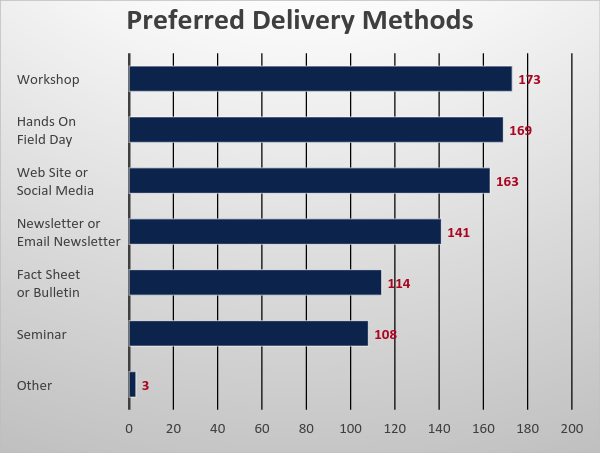
Figure 5. When choosing their top three mechanisms for information delivery, the 265 equine respondents favored workshops (65%) and hands on field days (64%) as their most preferred methods of receiving educational information. Web sites or social media also ranked highly (62%) and represent an efficient way to promote Cooperative Extension equine programs and publications.
Topics of Need. The equine portion of the survey presented respondents with twenty-two topics and asked them to rank each of them as: no need, slight need, moderate need, or critical need. These topics fell under general categories: 1) business management; 2) business planning; 3) training and behavior; 4) feeds, forages, and nutrition; and 5) horse health. In general, respondents were less interested in business management (Figure 6) and business planning (Figure 7) related subjects, even though 46% of respondents use their horses for business. With 54% of respondents not involved in equine business aspects, this would not be considered unusual.
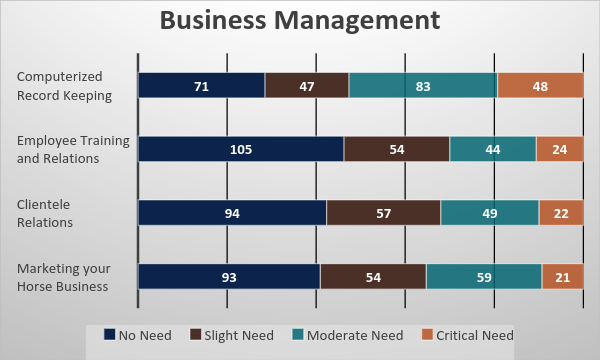
Figure 6. Equine respondents had very limited interest in Business Management topics, with computerized record keeping showing the highest need (53%) as measured by the percentage of total respondents choosing moderate to critical need.
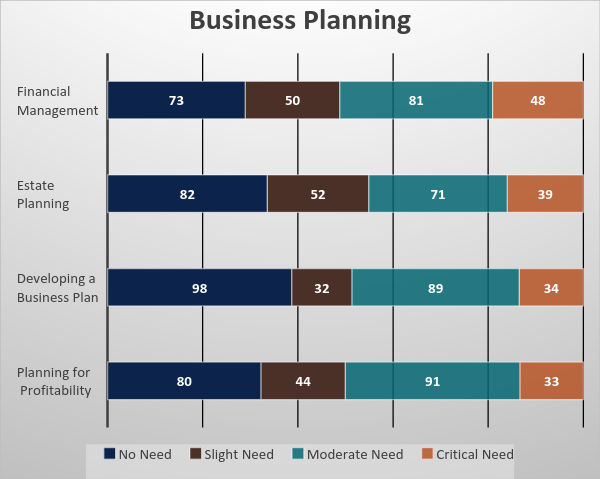
Figure 7. Business planning topics had very low perceived critical need overall, which could be in part due to the high level of non-business respondents.
Training and Behavior. With the exception of training and behavior modification, other topics in this category (e.g. facilities design, managing risk and liability) were not highly ranked (Figure 8). The well-known adage “safety doesn’t sell” could contribute to the perceived low needs of these topics. Although horse owners may not be as excited about these topics, they can be incorporated into other workshops and activities with higher perceived needs. However, regardless of the importance of safety, unless these topics are worked into programming as secondary topics, they are unlikely to draw horse owner attendance.
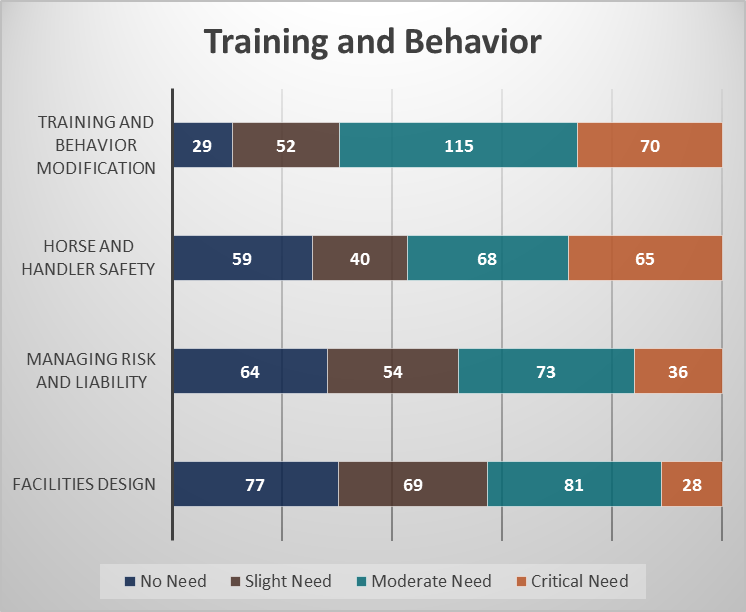
Figure 8. Training and behavior modification is an important and sought after topic by most horse owners (70%) as measured by the percentage of total respondents choosing moderate to critical need. In contrast, horse and handler safety (57%), managing risk and liability (48%), and facilities design (43%) are also extremely important, but less desired.
Feeds, Forages, and Nutrition. Of all of the topics presented, toxic plants and basic nutritional management of horses ranked first and third overall for highest number of moderate to critical need rankings (Figure 9). These topics encompass many of the most common questions encountered in the field by UA-CE faculty. Feeding the young growing horse was not as popular of a topic, possibly correlating with the low response to reproductive management sections under horse health.
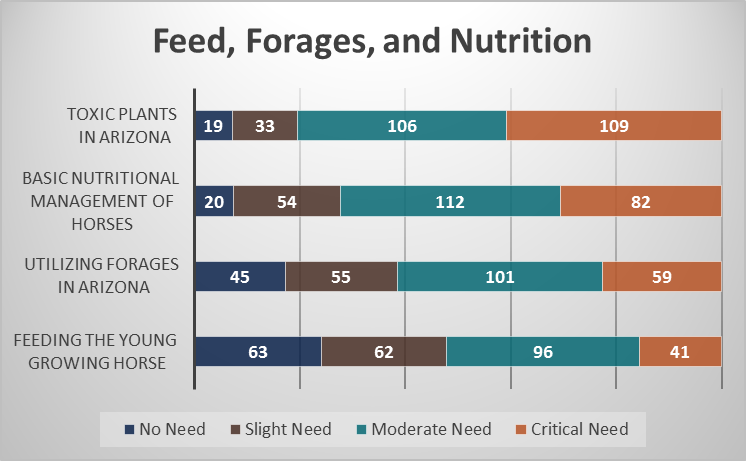
Figure 9. Feed, forages and nutrition topics ranked highest overall among respondents.
Horse Health. Several horse health topics stood out as having high importance to Arizona equine owners (Figure 10). Vaccination programs for Arizona, hoof care, lameness, and heat stress are topics that are either unique to Arizona or important to all horse owners, as evidenced by their frequent discussion in popular press magazines (e.g. Equus, Horse Illustrated). Reproductive management was one of the least desired topics of interest in this survey, possibly due to the high number of recreational owners (54%) who are not likely to be engaged in breeding. In addition, the recent push to “adopt don’t shop” has brought adopting rescued horses to the forefront and breeding, unless for a specific purpose, is often discouraged for the “average” horse owner.
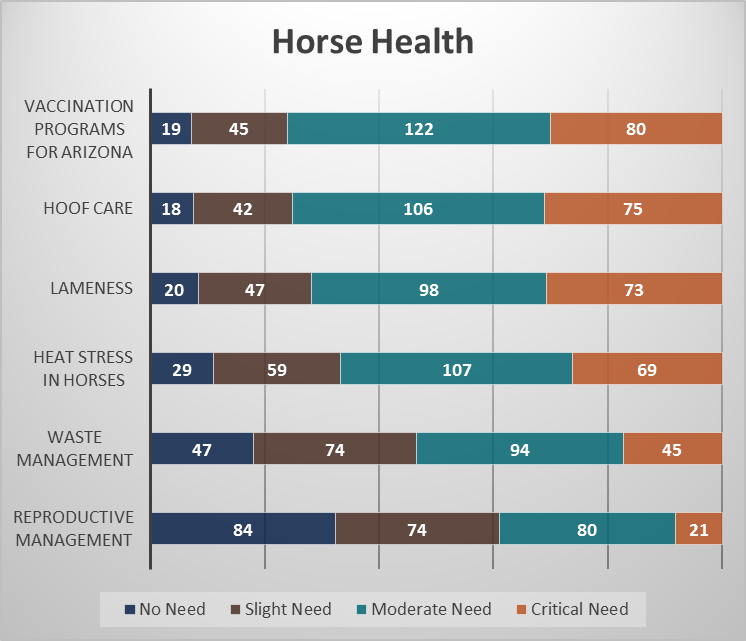
Figure 10: Four Horse Health topics stood out as having high importance to Arizona equine owners, as measured by the percentage of total respondents choosing moderate to critical need. These are: vaccination programs (76%), hoof care (75%), lameness (72%), and heat stress in horses (67%).
Conclusions
Cooperative Extension equine programming at the University of Arizona needs to be able to provide education and information relevant to all Arizona equine industry members. Different topics may align with diverse equine audiences: broad topics including horse care and management should attract the general horse-owning public, while horse and business management would be directed at the needs of equine professionals. In the process of building program goals, topics including safety, biosecurity, and equine welfare will be infused throughout. Although the 2002 survey was a useful model, it focused heavily on reproduction topics, which were not ranked highly in the 2016 survey. This updated data will help new extension personnel provide UA-CE education that is relevant to a broader audience, thus increasing the visibility and value of UA-CE equine programming. The needs and priorities of pleasure horse owners can be vastly different from those of ranchers with working horses, or equine business owners, or tribal members. Understanding the cultural nuances between these groups and how they use or enjoy their equine partners while still providing research-based, actionable information is vital to programming success.
Since this survey was completed, several seminars and workshops focusing on equine care and management have been presented at rancher events, youth events, and on the Navajo Nation. The Informed Arizona Equestrian Horse Health Series has been created, with three publications to date including “Rabies in Arizona: Equine Risk and Prevention”, and an article and a poster entitled “Barn Smarts for Biosecurity: Tips for Keeping Your Horse Safe and Healthy” (Greene and Wright, 2016a, Greene and Wright, 2016b, and Wright and Greene, 2016) have been published. In addition, a social media presence has been created through the establishment of a Cooperative Extension Equine Programming Facebook page. In January of 2017, the first annual Southern Arizona Equine Health Care Symposium was held in conjunction with several local veterinary clinics and industry partners and covered several topics respondents had identified as moderate to critical need. This event attracted nearly 200 participants, and planning for the second annual event is well underway. Survey results are already being utilized to direct Arizona Cooperative Extension Equine programming in areas of stakeholder identified priorities with the goals of engaging the entire equine community, delivering research based information, and fulfilling Arizona’s mission as a Land Grant institution. Finally, survey feedback has identified a need to increase stakeholder understanding that any and all 4-H programs in Arizona originate from the University of Arizona Cooperative Extension.
This survey created a baseline to identify and measure perceived needs and topics of interest from the equine stakeholders in Arizona. It provides a starting point from which to design programming, target workshops, seminars, and publications to bring pertinent, science based information to our clientele. This Qualtrics survey set up was designed to allow respondents to move quickly through the survey to rank their priorities on multiple topics, and still have the ability to add additional information that is important to them, but may not have been represented in the questions. In addition, the equine section was part of a larger livestock survey, which also gathered information on beef, dairy and small stock owners. As a result, data can be sorted to determine if needs for AZ ranchers who answered both beef and equine questions, differ from the recreational horse owner for program development purposes. All of this information can be used and adapted by any state or county cooperative extension agent or specialist as a needs assessment for their clientele. And, future surveys can provide a measure of impact when compared to the baseline data gathered in this survey.
References
Greene, E. A. & Wright, A. D. (2016a). The Informed Arizona Equestrian Horse Health Series. Barn Smarts for Biosecurity: Tips for Keeping Your Horse Safe and Healthy. University of Arizona Cooperative Extension. (az1709). Retrieved from: https://extension.arizona.edu/sites/extension.arizona.edu/files/pubs/az1709-2016.pdf
Greene, E. A. & Wright, A. D. (2016). Barn Smarts for Biosecurity: Tips for Keeping Your Horse Healthy (Poster). University of Arizona Cooperative Extension. Retrieved from: https://extension.arizona.edu/sites/extension.arizona.edu/files/resources/horse-biosecurity.pdf
Kerna, A., Frisvold, G., Tronstad, R., & Teegerstrom, T. (2014). The Contribution of the Beef Industry to the Arizona Economy. University of Arizona Cooperative Extension. Retrieved from: https://cals.arizona.edu/arec/sites/cals.arizona.edu.arec/files/publications/contrib_beef_industry_to_az_econ_complete.pdf
Qualtrics (2016). Provo, UT, USA; Qualtrics. Retrieved from: http://www.qualtrics.com
Teegerstrom, T., & Tronstad, R. (2017). Arizona Ranching Budgets: 2016. University of Arizona Cooperative Extension. (az1734). Retrieved from: https://extension.arizona.edu/sites/extension.arizona.edu/files/pubs/az1734-2017.pdf
United States Department of Agriculture, National Agriculture Statistics Service. (2014). 2012 Census of Agriculture: Arizona State and County Data (Vol. 1, Geographic Area Series, pp. 19-21). Retrieved from: https://www.agcensus.usda.gov/Publications/2012/Full_Report/Volume_1,_Chapter_1_State_Level/Arizona/azv1.pdf
Wright, A. D. (2015). Announcing the 2015 Statewide Livestock Survey. Arizona Cattlelog: Official Publication of the Arizona Cattle Growers' Association, 70(4), p19.
Wright, A. D. & Greene, E. A. (2016). The Informed Arizona Equestrian horse health series. Rabies In Arizona: Equine Risk And Prevention, University of Arizona Cooperative Extension. (az1700). Retrieved from: https://extension.arizona.edu/sites/extension.arizona.edu/files/pubs/az1700-2016.pdf
